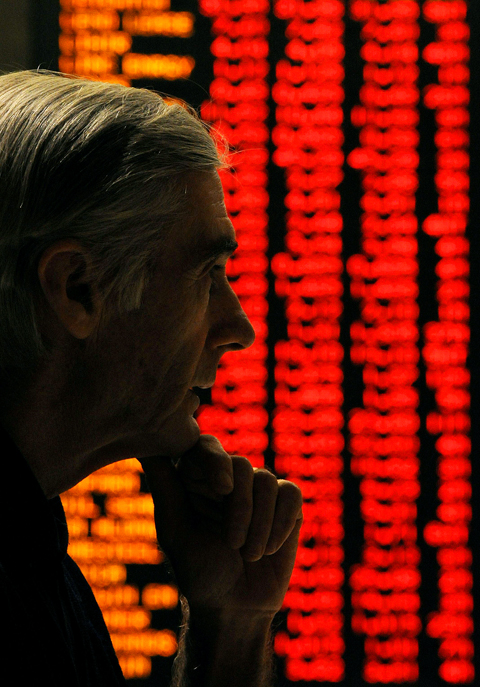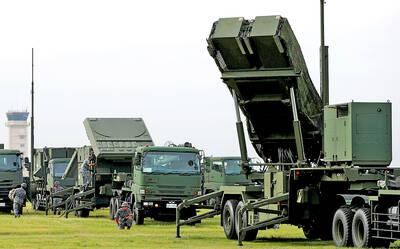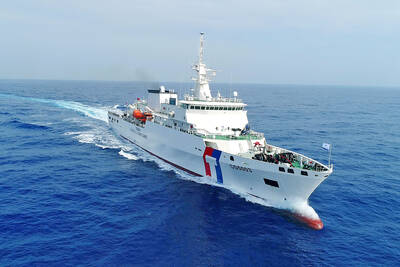Australian Treasurer Wayne Swan yesterday described as “myths” claims a planned new 40 percent tax on mining profits would hit investment or push up domestic prices.
In a weekly economic note, Swan said the new 40 percent “resource super profits tax” would replace an inefficient royalties system and as a result, should boost investment.
Prices of most commodities subject to the tax were set on international markets, he said, and Treasury analysis showed it should not affect prices of coal, gas or electricity within Australia.

PHOTO: AFP
The new tax has caused an outcry from mining companies since it was announced earlier this month. They have put a series of major projects on hold and have been backed by the conservative opposition, which has vowed to cancel the tax if it wins an election due later this year.
In a recorded interview broadcast yesterday, Fortescue Metals Group chief executive Andrew Forrest said the resources sector had saved Australia during the global downturn from a crisis such as that in Greece and the new tax threatened its future by deterring investment.
However, Swan said mining companies were currently getting a better deal than the average Australian taxpayer.
Thanks to various concessions, Australian-owned mining companies currently pay an effective 17 percent rate of company tax, he said, while foreign-owned companies paid just 13 percent. Those figures are far below the official company tax rate of 30 percent and well below the effective rates paid by the retail and manufacturing industries, he said.
“All companies in Australia are required to pay company tax, but very few businesses receive as their primary input the non-renewable resources that belong to the Australian people,” Swan said.
“No other business would try to argue that they should get their primary input for free courtesy of the Australian people just because they pay company tax — and neither should Australia’s largest mining companies. In our tax system, an ordinary worker who earns an extra dollar through their hard work pays higher tax, but a mining company that earns massive amounts pays the same flat, low rate of company tax,” he said.
Swan also denied the tax would harm existing projects, saying mining companies would receive “generous recognition of their past investment costs.”
However, Forrest said in his interview with the Australian Broadcasting Corp that bankers had pulled out of some planned Fortescue projects, including the A$9 billion (US$7.4 billion) Solomon Hub project in Western Australia State, to create an iron ore mine producing 160 million tonnes a year.
China is a key customer for Australia’s resources, particularly iron ore, and Forrest said a note from a Chinese consulate had made clear that the tax had undermined Australia’s competitive advantage.
“[The note] said Australia’s competitive advantage to China over Brazil, over India, over these massive competitors Australia competes against, that competitive advantage we did have is now gone,” Forrest said.
The new tax is set to raise about A$12 billion in its first two years and is scheduled to be implemented from July 2012. Since it was announced, a series of mining companies have suspended major investment projects.

MILITARY BOOST: The procurement was planned after Washington recommended that Taiwan increase its stock of air defense missiles, a defense official said yesterday Taiwan is planning to order an additional four PAC-3 MSE systems and up to 500 missiles in response to an increasing number of missile sites on China’s east coast, a defense official said yesterday. The official, who spoke on condition of anonymity, said that the proposed order would be placed using the defense procurement special budget, adding that about NT$1 trillion (US$32,88 billion) has been allocated for the budget. The proposed acquisition would include launchers, missiles, and a lower tier air and missile defense radar system, they said The procurement was planned after the US military recommended that Taiwan increase

POLITICAL AGENDA: Beijing’s cross-strait Mid-Autumn Festival events are part of a ‘cultural united front’ aimed at promoting unification with Taiwan, academics said Local authorities in China have been inviting Taiwanese to participate in cross-strait Mid-Autumn Festival celebrations centered around ideals of “family and nation,” a move Taiwanese academics said politicizes the holiday to promote the idea of “one family” across the Taiwan Strait. Sources said that China’s Fujian Provincial Government is organizing about 20 cross-strait-themed events in cities including Quanzhou, Nanping, Sanming and Zhangzhou. In Zhangzhou, a festival scheduled for Wednesday is to showcase Minnan-language songs and budaixi (布袋戲) glove puppetry to highlight cultural similarities between Taiwan and the region. Elsewhere, Jiangsu Province is hosting more than 10 similar celebrations in Taizhou, Changzhou, Suzhou,

TWO HEAVYWEIGHTS: Trump and Xi respect each other, are in a unique position to do something great, and they want to do that together, the US envoy to China said The administration of US President Donald Trump has told Chinese President Xi Jinping (習近平) “we don’t want any coercion, but we want [the Taiwan dispute] resolved peacefully,” US ambassador to China David Perdue said in a TV interview on Thursday. Trump “has said very clearly, we are not changing the ‘one China’ policy, we are going to adhere to the Taiwan Relations Act, the three communiques and the ‘six assurances’ that were done under [former US president Ronald] Reagan,” Perdue told Joe Kernen, cohost of CNBC’s Squawk Box. The act, the Three Joint Communiques and the “six assurances” are guidelines for Washington

DEEPENING TIES: The two are boosting cooperation in response to China’s coercive actions and have signed MOUs on search-and-rescue and anti-smuggling efforts Taiwan and Japan are moving to normalize joint coast guard training and considering the inclusion of other allies, the Japanese Yomiuri Shimbun reported yesterday. Both nations’ coast guards in June sent vessels to the seas south of the Sakishima Islands to conduct joint training, the report said, adding that it was the second joint maritime training exercise since the nations severed formal diplomatic ties in September 1972. Japan dispatched the Nagoya Coast Guard’s Mizuho, a 134m, 6,000-tonne patrol vessel which can carry a helicopter, while the Coast Guard Administration (CGA) sent the 126m, 4,000-tonne Yunlin, one of its largest vessels, the report